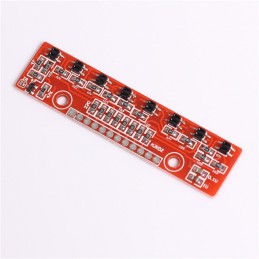Description
Soil Moisture Sensor: Optimize Irrigation for Healthier Plants
- Introduction to Soil Moisture Sensors
- How Soil Moisture Sensors Work
- Benefits of Using a Soil Moisture Sensor
- Types of Soil Moisture Sensors
- Choosing the Right Soil Moisture Sensor for Your Needs
- Installing and Using a Soil Moisture Sensor
- Conclusion
Introduction to Soil Moisture Sensors
A Soil Moisture Sensor is an essential tool for any gardener, farmer, or landscaper looking to optimize their irrigation practices. By accurately measuring the moisture content in the soil, this device helps ensure that plants receive the right amount of water—no more, no less. This not only saves water but also promotes healthier plant growth, making it a must-have for anyone serious about cultivating a thriving garden or crop.
How Soil Moisture Sensors Work
Understanding the Basics
At its core, a Soil Moisture Sensor measures the volumetric water content in the soil. This is typically achieved through sensors that detect changes in electrical resistance or capacitance caused by moisture levels. When the soil is dry, the sensor will show high resistance, and when it is wet, the resistance will be lower. Some advanced sensors can even measure soil temperature, providing a more comprehensive understanding of the soil’s condition.
Real-Time Monitoring
Many modern Soil Moisture Sensors come equipped with wireless capabilities, allowing users to monitor soil conditions in real-time through a smartphone app or a dedicated monitoring system. This feature is especially useful for large-scale operations, where manually checking soil moisture across multiple fields or garden beds would be impractical.
Benefits of Using a Soil Moisture Sensor
Water Conservation
One of the primary benefits of using a Soil Moisture Sensor is the significant reduction in water usage. Overwatering is a common issue in gardening and agriculture, leading to wasted water and potential plant damage. By using a soil moisture sensor, you can water your plants only when necessary, leading to more efficient water use.
Improved Plant Health
Consistent and appropriate watering is crucial for plant health. A Soil Moisture Sensor helps you maintain optimal moisture levels, preventing the risks associated with both under-watering and over-watering. This ensures that your plants have the right environment to grow strong and healthy.
Cost Savings
By reducing water usage and avoiding plant damage, a Soil Moisture Sensor can lead to significant cost savings over time. Whether you are a homeowner maintaining a garden or a farmer managing large fields, the initial investment in a soil moisture sensor can quickly pay off.
Types of Soil Moisture Sensors
Capacitance Sensors
Capacitance sensors are among the most popular types of Soil Moisture Sensors. They measure soil moisture by detecting changes in the dielectric constant of the soil. These sensors are generally more accurate and provide consistent readings, making them ideal for precise irrigation management.
Tensiometers
Tensiometers are another type of Soil Moisture Sensor that measures the tension or suction the soil exerts on water. These are particularly useful for detecting the point at which plants begin to experience water stress, ensuring timely irrigation.
Gypsum Block Sensors
Gypsum block sensors use a block of gypsum placed in the soil, which changes its electrical resistance based on the moisture level. This type of Soil Moisture Sensor is often used for long-term monitoring, as it provides reliable readings over extended periods.
Choosing the Right Soil Moisture Sensor for Your Needs
Consider Your Soil Type
Different types of soil have different moisture retention properties, which can affect the accuracy of a Soil Moisture Sensor. For example, sandy soils drain quickly, while clay soils retain water longer. Understanding your soil type is crucial in choosing the right sensor for your needs.
Determine Your Budget
While basic Soil Moisture Sensors can be relatively inexpensive, advanced models with additional features like wireless connectivity and temperature measurement can be more costly. Determine your budget and prioritize the features that are most important to you.
Evaluate Ease of Use
Consider how easy the sensor is to install and use. Some Soil Moisture Sensors require calibration and regular maintenance, while others are more plug-and-play. If you are new to using these devices, a simpler model might be more suitable.
Installing and Using a Soil Moisture Sensor
Step-by-Step Guide
- Choose the Location: Select an area in your garden or field where you want to monitor soil moisture. The sensor should be placed in a spot that represents the average moisture level of the area.
- Insert the Sensor: Carefully insert the Soil Moisture Sensor into the soil, ensuring it is placed at the root level of your plants. For accurate readings, avoid placing it too close to the plant’s stem or in an area prone to excessive water retention.
- Connect to the Monitoring System: If your sensor is equipped with wireless capabilities, connect it to the monitoring system or smartphone app. Follow the manufacturer’s instructions for calibration and setup.
- Monitor and Adjust: Regularly check the moisture levels and adjust your watering schedule accordingly. Many sensors provide alerts when the soil reaches critical moisture levels, helping you respond promptly.
Conclusion
Investing in a Soil Moisture Sensor is a smart move for anyone looking to improve their irrigation practices, conserve water, and promote healthier plant growth. Whether you’re a home gardener or a professional farmer, this device offers valuable insights into your soil’s condition, helping you make informed decisions about when and how much to water.






Reviews
There are no reviews yet.